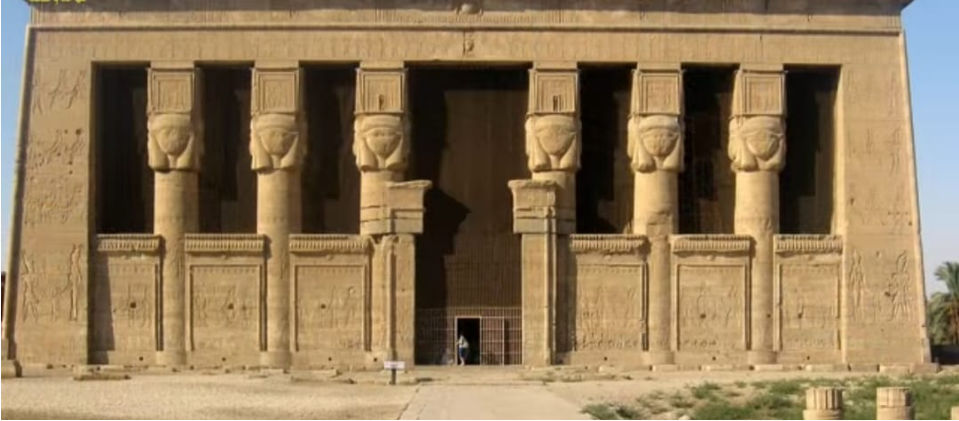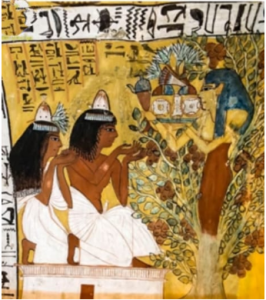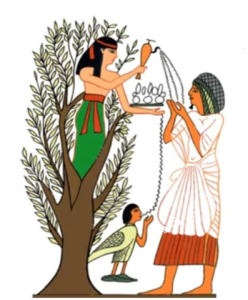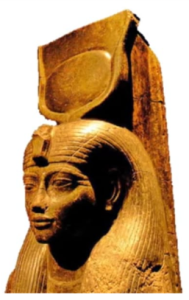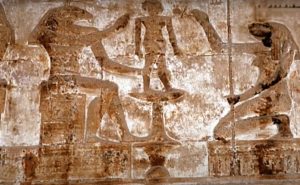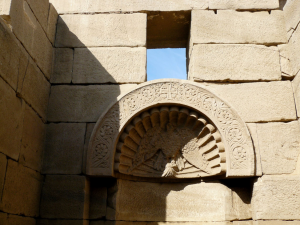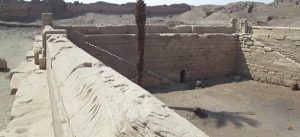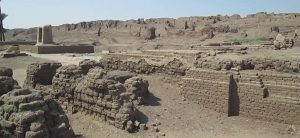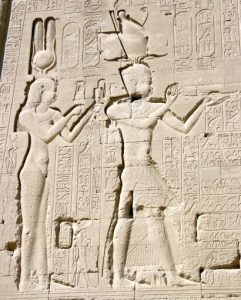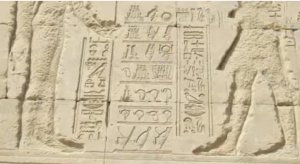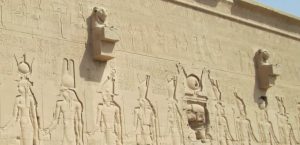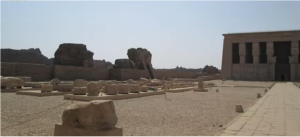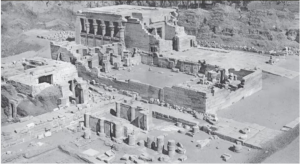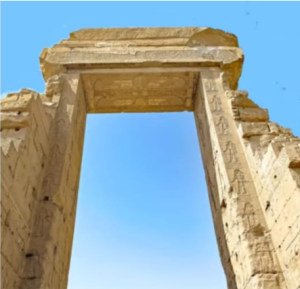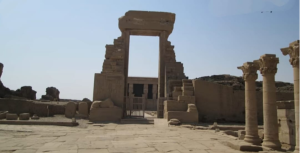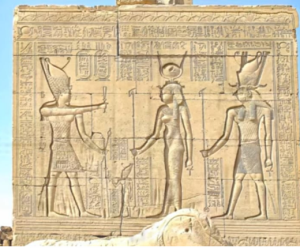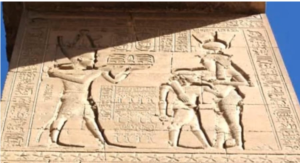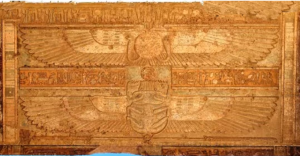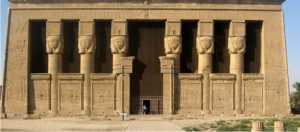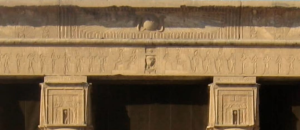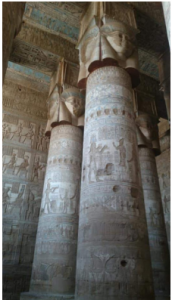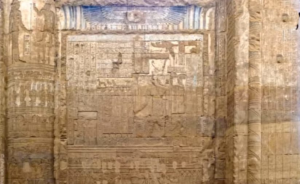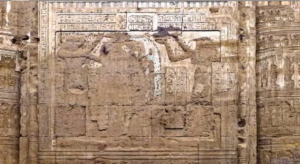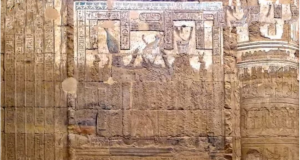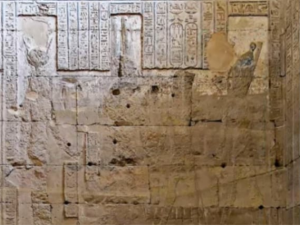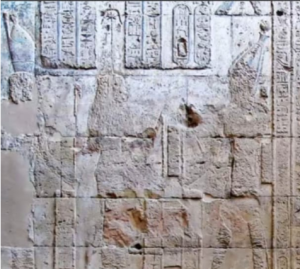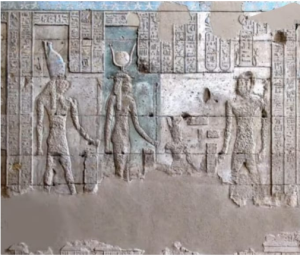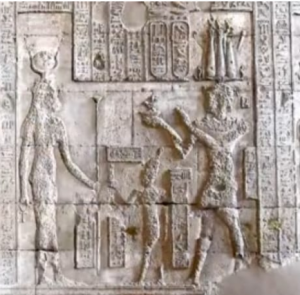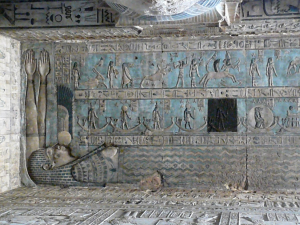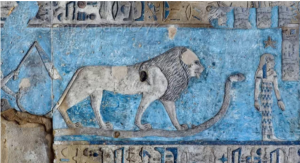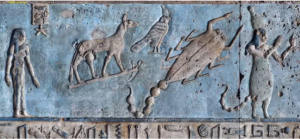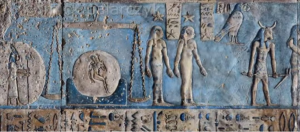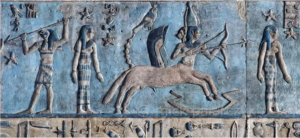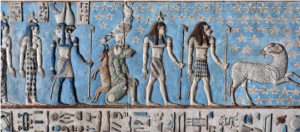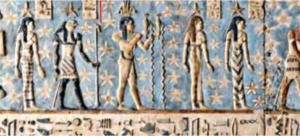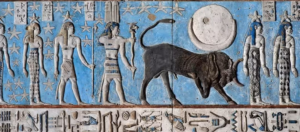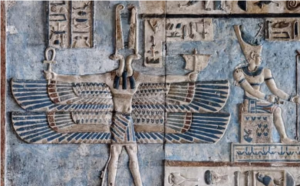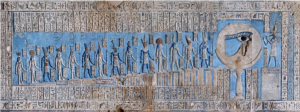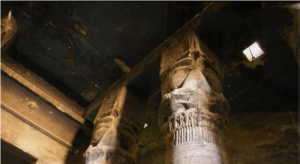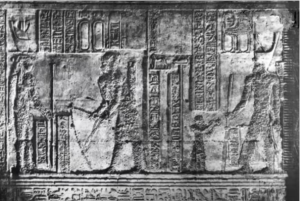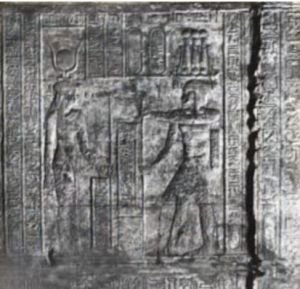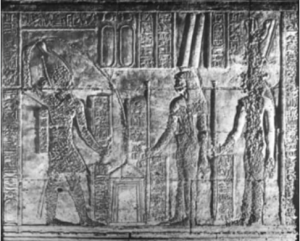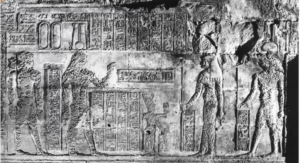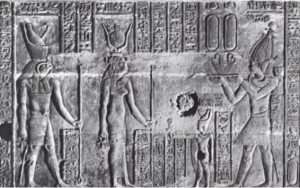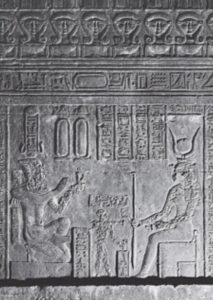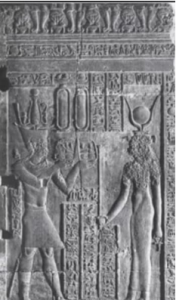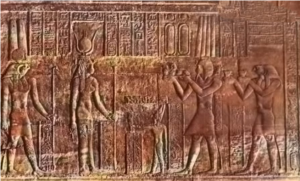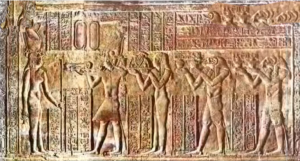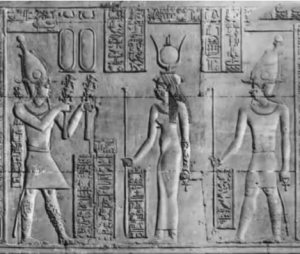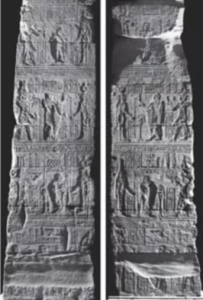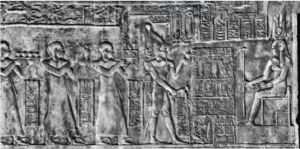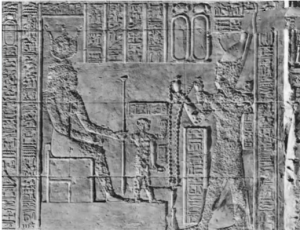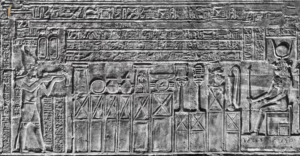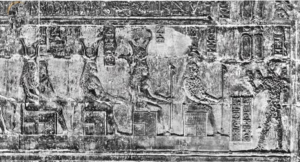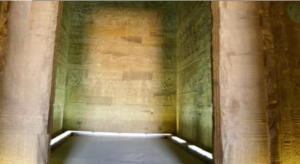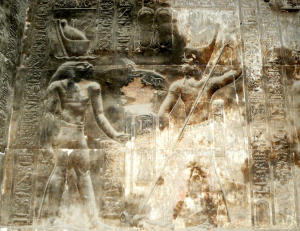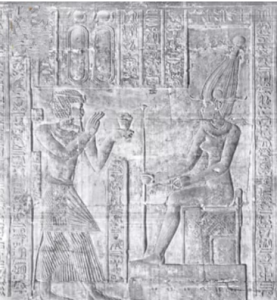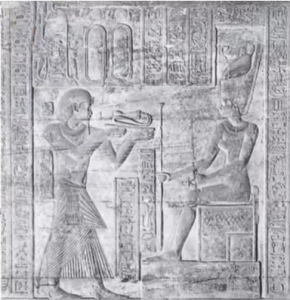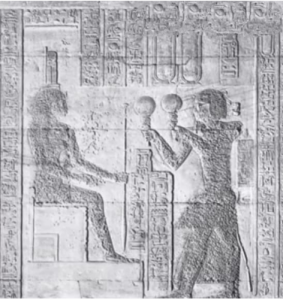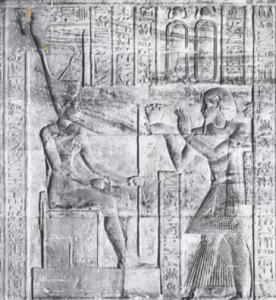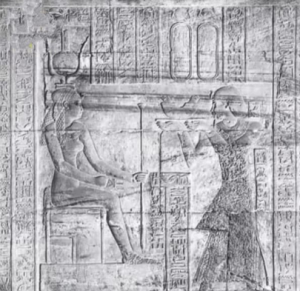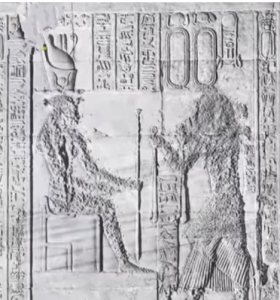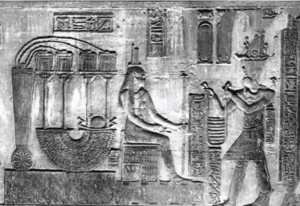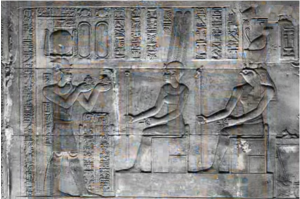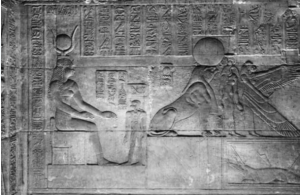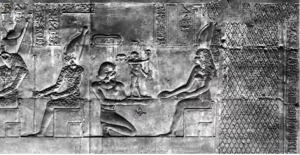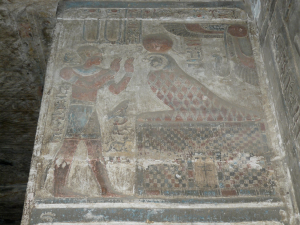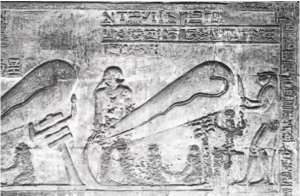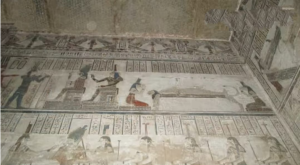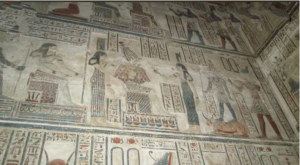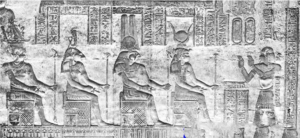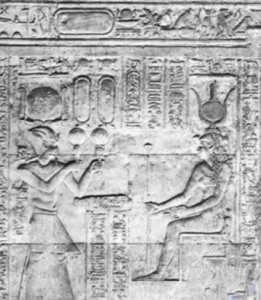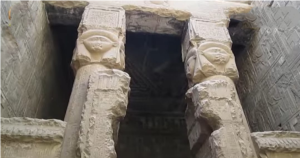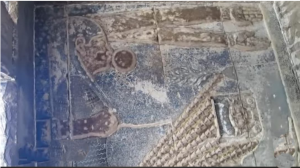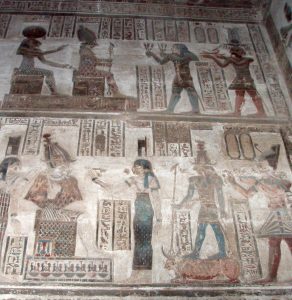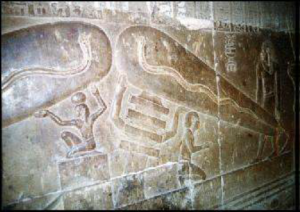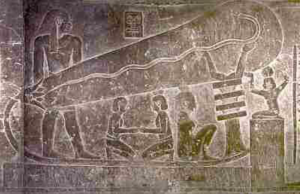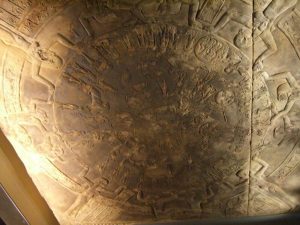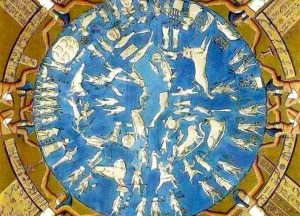Dendera temple
The city of Dendera is located 55 kilometers north of Luxor on the western bank of the Nile. Dendera was the capital of the sixth region, known as the region of the crocodile, of the Upper Egyptian regions. In the Pharaonic era, it was called Ta Net Ra, meaning the city of the goddess, referring to the goddess Hathor. Then it was known in the Greek language as “Tentyris,” then it was known in the Arabic language as Tantra, then the name changed to Dendera.
The temple of Hathor
It Dates back to the reign of King Khufu of the Old Kingdom, then King Pepi I, then King Nectanebo II in 342 BC. Then, in the era of Ptolemy IX (116 BC), he began to complete the temple and construction continued until the reign of Septimius Severus in 34 AD. It was dedicated to the great goddess Hathor, her husband Horus, and their son Hor- Ihy (Hor-Sematawy, meaning unifier of the two lands). The temple was discovered by the French scholar Mariette.
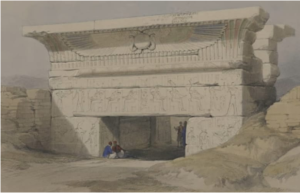
The discovery of the Temple of Dendera by Mariette
The goddess Hathor
Hathor is one of the most important Egyptian goddesses. She is the goddess of music, singing, beauty, and motherhood. She is depicted as a beautiful woman with a cow’s head, and also depicted with the face of a woman and the horns of a cow with the sun’s disk between her horns. Her animal symbol is the cow. Hathor was given many titles, the most important of which is “the owner of the necklace” because she is depicted wearing a necklace that has magical powers and brings happiness to whoever wears it. Hathor was considered the guardian of the western necropolis in Thebes. Hathor was also called “the lady of the sycamore tree,” as the sycamore tree is an evergreen tree that lives for a long time and is planted near tombs because the ancient Egyptians believed that the sycamore tree feeds the newly deceased so that they can complete their journey to the afterlife. Hathor was called “the golden one,” meaning the goddess of gold.
Hathor’s most important tasks
She is the goddess who protects motherhood and childhood. She helped protect pregnant women and cared for the child in the first week of birth. On the seventh day of birth, her daughters (called the seven Hathors) come and play the tambourine and musical instruments in celebration of the seventh day, because the newborn’s hearing is completed on the seventh day. This is an Egyptian custom that has been passed down to the present day to celebrate the seventh day of the child (the first week).
Hathor, Guardian of the Western Necropolis
Hathor as a lady of Sycamore Tree
Hathor, Goddess of Gold
Temple Complex
The temple consists of:
• The Main Temple and the Birth Temple (Mammisi): Construction began under King Nectanebo II (342-332 BC). Notable scenes include Khnum shaping a child on a potter’s wheel, with the goddess Heqat with a frog’s head in front of him.
• A Church: Dating back to the 5th century AD, adorned with a clam-shell (henia) motif.
• The Temple of the Goddess Isis and the Sacred Lake: This lake’s water was used for rituals and ceremonies associated with the temple, and it also included a nilometer.
• The Sanatorium: A building for treating the sick spiritually or physically. It had seats for relaxation and waiting for their turn to receive appropriate treatment, whether physical or psychological.
• Cleopatra’s Bath: Many legends surround this bath. Some barren women believed that bathing in it would enable them to conceive. Unmarried girls believed that bathing in it would lead to marriage. It is said that Cleopatra bathed in milk, especially horse’s milk, which gave the body radiance and attractiveness. Since the temple was completed during the lifetime of Cleopatra and her father, some believe that she bathed in pools like this in Alexandria. Therefore, women believed that this place fulfilled their desires for marriage and pregnancy.
• The Open-Air Museum: This displays pieces that were not found in their original place within the temple.
• The Outer Wall: One of the most important scenes on the outer wall depicts Cleopatra VII and her son Caesarion approaching the goddess. There is a unique inscription representing the 24 crowns of ancient Egypt.
• Gutters: A distinctive feature of the Temple of Dendera is the gutters( rainwater collection basins) shaped like lions to protect the exterior appearance of the temple.
Khnum shaping the child on the potter’s wheel (Mammisi)
Henia from the Coptic Church built inside the Temple of Hathor at Dendera
The Sacred Lake
The Sanatorium (House of Healing)
Caesarion with the double crown and his mother Cleopatra
Shapes of the gutters for the royal crowns
Shapes of the gutters for the royal crowns
The open-air museum in the outer courtyard of the temple
Panorama of the Temple of Dendera
The Domitian Gateway:
These gates are made of sandstone and bear the cartouches of some Roman emperors. This gate was also known as the Gate of Hathor, as her procession would enter and exit through it.
Important scenes on the gate:
• On the north: Emperor Domitian, wearing Egyptian clothing and the double crown, stands before the goddess Hathor and the god Horus, with their son Hor-Ihy holding the sistrum of Hathor.
• We also see Emperor Domitian pouring wine on the ground.
• We see Isis breastfeeding Horus, and Emperor Domitian stands before her offering her offerings.
• Below this scene, we see Isis wearing the double crown, and Domitian offers her temple to her.
• On the right of the gate: We see Hathor breastfeeding Horus, and Domitian offers her two jugs of milk.
• There is also an inscription of the emperor offering two crowns to Hathor and Sekhmet.
• On the right and left of the gate: We see depictions of guardian deities holding knives to kill evil spirits.
• The ceiling of the gate: It is decorated with the image of a winged scarab pushing the sun disk in front of it, then the winged sun disk appears protected by two cobras to protect the entrance.
• The top of the gate from the inside: In the middle, we see the image of Hathor, above her is the sun disk between the horns of a cow, and on the right and left are images of different deities.
the goddesses who guard the gate
Domitian’s Gate
Emperor Domitian in front of Hathor and Horu
Isis breastfeeding Horus, and Domitian presents offerings in front of her:
Ceiling of the Domitian Gate
The facade of the temple:
It contains 6 Hathoric columns, and between these columns, we see wall curtains. This architectural style was the most important feature of Egyptian temples in the Ptolemaic era. Hathor was depicted on all four sides of the column as evidence of her control over the four directions. There was also a symbolism for the presence of Hathor on 6 columns and 4 sides, representing the 24 hours of the day. On these curtains, scenes of purifying the king and offering sacrifices to the main deity are depicted. The function of these curtains was to hide what was happening inside the main hall of columns.
The Temple Facade (Hathoric Columns and Wall Curtains):
Hathor and the winged sun disk above the temple facade:
Columns with Hathoric capitals:
The Great Hall of Columns:
It was known in ancient Egyptian texts as “Auskhet Kha U”, meaning the Hall of Manifestation. It consists of 24 columns divided into 4 rows. It was built during the reign of the Emperor Tiberius. It is a Roman hall because all the names on it refer to Roman emperors.
On the right of the entrance (behind the wall curtains) we found:
Hathoric Columns in the Hall of Manifestation
Scene of Emperor Nero wearing the Lower Egyptian Crown
The king with the gods Thoth and Horus undergoing purification
Scene of the king’s coronation by the goddesses Nekhbet and Wadjet
Scenes on the right side of the hall:
The king holding the hand of Montu (god of war in Thebes) and Atum, the head of the Ennead of Heliopolis, while Hathor of Dendera grants him kingship and determines his reign.
The king establishes the temple’s boundaries by placing stakes at its four corners, in the presence of Isis and assisted by Seshat, the goddess of measurement and writing.
The king offers a model of the temple of Hathor, alongside her husband Horus of Edfu and their son Hor Sematawy.
The king presents the maat feather, symbolizing justice, to Hathor.
On the left side of the hall:
Similar scenes, but here the king wears the Upper Egyptian Crown.
The Hall’s Ceiling:
The ceiling retains its vibrant colors. The upper ceiling can be reached via stairs adorned with reliefs depicting statues of Hathor carried by priests and scenes celebrating the New Year. The ceiling is divided into seven sections: the first three sections in the east opposite to the last three sections in the west, and they depict the hours of the night, the hours of the day, and other astronomical scenes. We find the sky goddess Nut, her body arched as if containing the universe within her arms and legs. Nut’s clothing is depicted as ripples, symbolizing the primordial waters (Nun) from which the world was created.
Dendera temple’s Ceiling
The goddess Nut, the goddess of the sky, and a depiction of the feasts of the goddess Hathor
Zodiac signs on the ceiling of the Temple of Dendera:
Leo
Scorpio
Libra
Sagittarius
Capricorn
Aquarius (represented by the god Hapi holding two vases)
Pisces
Taurus
a winged representation of the winds
Lunar mansions
The Small Hall of Columns
A small hall, its ceiling supported by six composite columns. There are openings in the ceiling that were used for lighting and ventilation. Most of the scenes depicted on its walls are similar to those in the Great Hall of Columns. There is a scene of the king with Horus-Ihy, planting a Willow tree in front of Horus and Hathor. The Willow tree was considered sacred as it was the tree of Osiris and was used to shade his coffin in the myth of Isis and Osiris. His spirit would rest on its branches and then transform into a phoenix.
Ceiling of the Small Hall of Columns
The most important scenes in Small Hall of Columns
A scene of the king, with a priest burning incense, cutting the first hole in the presence of the goddess Hathor.
The king places the first foundation stone in the building in front of Hathor.
The king throws incense balls over the temple in the presence of Hathor and Isis
The god Ptah presents the king to the goddesses Hathor and Horus
The Six Chambers in the Small Hall of Columns
These six chambers were used to store the most important offerings presented to the temple. On the right, there are 3 chambers used consecutively. The first (Chamber of Treasures) was used to store silver and precious stones. The second (Chamber of the Nile) was used to store vessels of sacred Nile water, wine, and oils. The third was used to store various solid offerings
Scenes from the Treasury Chamber
The king offers the ushk collar to Hathor.
The king offers a menat necklace, a necklace of happiness
Scenes from the Nile Chamber
The king kneels, offering Hathor the maat feather, with the presence of the seven faces of Hathor.
Scenes from the Chamber of Solid Offerings
The king offers food to Hathor.
On the north, there are 3 chambers used consecutively.
The first (Laboratory Room) was used to store perfumes and aromatic substances such as incense and fragrances. The second (Harvest Room or Storehouse) was used to store vessels with various contents. The third was for various offerings.
Scenes from the Laboratory Room
The king offers a perfume vase shaped like a sphinx to Hathor and Horus of Edfu.
The king burns incense in front of Hathor.
Scenes from the Harvest Room
The king offers bouquets of flowers to Isis and Osiris.
Scenes from the Chamber of Various Offerings
Emperor Augustus offers offerings to Hathor (at the door of the chamber).
The Hall of Offerings
What distinguishes it most is the presence of two staircases, one spiral ascending and the other straight descending. This is due to the existence of inscriptions for the New Year celebrations. The New Year festivals were associated with the god Horus. Here, the staircases represent the ascending spiral of the falcon and its straight descent. It contains the stands of offerings presented to the gods of the temple. On the thresholds of the hall, we find a scene of the king followed by four priests, and the king is burning incense and pouring wine, in celebration of the New Year.
The Ascending Staircase Depicted on it are the New Year celebrations.
The King Performing the Ritual of Pouring Wine
The King Carrying Vessels in Front of Isis Seated on a Throne
A Scene of the Seven Symbols of Hathor
The Western Side of the Hall of Offerings
We find the linen chamber, which was used to store the textiles and clothing that were placed on the statues of Hathor. What distinguishes this chamber most is the scenes of the seven Hathors who protected the child during the first week of birth.
The king offering sacrifices to the seven Hathors, here depicted as a woman.
The Hall of the Nine
Known as the hall of the assembly of the gods. The inscriptions in it depict the secrets of the worship of Hathor and her functions as the eye of the sun that gives life and light.
The Holy of Holies
The purest place in the temple. It was always dark to give awe to the worship. It symbolizes the womb of the goddess Nut from which the god is born. It contains the shrine with a statue of the goddess and her boat, as well as her special tools.
The Holy of Holies
The king with the crown of Upper and Lower Egypt in front of Horus inside the walls of the Holy of Holies, holding the scepter.
Scenes of Hathor and Isis On the left Scenes in front of Hathor
The king offers natron’s salt to Nekhbet
The king offers a Menat necklace to Hathor
The king offers mirrors to Hathor
On the right Scenes in front of Isis
The king offers natron to Buto
The king offers the woskh necklace to Isis
The king offers clothing to Isis
The Passageway Around the Holy of Holies
The passageway contains 11 chambers, named consecutively:
1. The Purification Chamber (dedicated to rituals for renewing the river flood).
2. The Chamber of the Covenant (Chamber of Jewelry), most of its scenes depict offerings of necklaces.
3. The Throne Chamber (Ra’s Chamber), containing scenes of Horus as a falcon.
4. The Chamber of Lower Egypt.
5. The Chamber of the Torch, located behind the axis of the Holy of Holies, where a wooden pillar is placed, topped by a golden head of the goddess Hathor as a symbol of existence.
6. The Chamber of Vessels (House of Vessels), where vessels for daily use are placed.
7. The Chamber of the Sistrum (Chamber of Upper Egypt), dedicated to the god Osiris.
8. The Chamber of Union, the most important scene of which is the birth of Horus, also found in one of the temple’s crypts.
9. The Chamber of the God Sokar, the chamber is dedicated to Sokar’s activities in the afterlife.
10. The Birth Chamber.
11. The Resurrection Chamber
The scene of the Chamber of the Covenant (Chamber of Jewelry)
Scenes from The Throne Chamber (Ra’s Chamber)
Scenes from The Chamber of the Torch
king Bibi I Kneeling, Offering a Sacrifice to Hathor
Chamber of Upper Egypt
The king worshipping the falcon Horus in the protection of Wadjet
A scene from the Chamber of Union
A lotus flower topped with a glass bulge from which a snake emerges (the birth of Horus)
Scences fromThe Chamber of the God Sokar
scenes from The Birth Chamber
The Chamber of Nut (The Chamber of the New Year)
It is called Wabet, meaning the pure chamber. We find an important scene of the sky goddess Nut swallowing the sun disk. Here, the meaning is not the alternation of night and day but rather the alternation of years. She swallows a year, meaning one year ends and a new one begins. Therefore, we notice the presence of Nut, meaning a new year, and we see in the scenes the goddess Hathor in a beautiful form, as if she were a princess and queen of the New Year (similar to setting off fireworks on New Year’s Eve today). She is depicted as a beautiful woman wearing a short dress and not as a cow. The priests offer sacrifices in the small courtyard and they are depicted in a wonderful way. We note the presence of processions of gods that include all the regions of Egypt, which indicates that the celebration includes all parts of the country. This indicates that the New Year celebration was known in Egypt before the whole world.
The gate of Nut’s Chamber
Nut on the chamber ceiling
Osiris Chamber
The wall scenes in the chamber begin with a procession of the priests of Upper and Lower Egypt, accompanied by the king, to participate in the Osirian festival. Then the scenes depict the stages of the Osirian myth, beginning with the gathering of the limbs of the god, the making of Osirian statues, the slaying of the god Set, the protection of Osiris throughout the hours of the day by the goddesses of protection, the resurrection of Osiris, and finally the celebration of the god Sokar and the erection of the djed pillar. We find that the procession of the priests of Egypt has occupied the lower walls of the chambers. In the eastern chambers, we find an inscription of the priests of Lower Egypt walking behind the king, carrying in their hands the symbols of the regions from which they came. Similarly, we find in the western chambers a procession of the priests of Upper Egypt.
Offering sacrifices to the god Osiris
The Crypts of the Temple of Dendera
A place dedicated to the celebration of the goddess Hathor. Golden statues of the deities and the ritual tools necessary for religious ceremonies emerge from it. Precious statues and valuable tools are kept inside. These crypts contain inscriptions and scenes, the most important of which is the scene of opening the stone door, and the scene of the winged scarab pushing the sun disk before it. There is also a scene of the ritual of offering bread to the goddess Hathor, the Lady of Dendera. In addition to the ritual of stabbing the crocodile, representing evil, in front of the god Horus with two blades. One of the interesting myths about the crypts is the existence of an inscription that became famous as the “Dendera Light”, where it was said that the Egyptians had electricity. This is of course wrong. The correct interpretation is: The Egyptians believed that before anything else existed, there was a vast primordial sea of nothingness. They believed that the first thing to emerge from this sea was the lotus flower, perhaps because the lotus closes at night and sinks underwater. In the morning, it reappears and blooms again. It was believed that the lotus flower gave birth to the first god, who was often associated with the sun, after the god Atum was merged with the sun god Ra, thus becoming Atum, the god who created everything else. After that, he is actually represented as a snake, so it is the snake in these inscriptions, not the electric light bulb. The scene can be interpreted as the emergence of the universe from the lotus in a bubble of air (perhaps symbolizing the birth of Horus)
Image of a Lotus Flower and the Djed Pillar
Inscriptions on one of the walls of the Hathor Temple crypts, showing her specific rituals
The Dendera Zodiac
A most important element of the Temple of Dendera, known as the Circle of Celestial Constellations or the Dendera Zodiac. It indicates the great advancement of the ancient Egyptians in astronomy and astrology. Unfortunately, this celestial circle was removed from the ceiling of the temple and transferred to the Louvre Museum in France during the nineteenth century. The temple today retains a replica in its original place, containing goddesses who support the sky and define the four corners of the universe. And the children of Shu carry the sky and are responsible for the movement of the sun on the horizon. They are the groups of stars and the permanent constellations, and Nut, the container of the sky.
The Dendera Zodiac
the Circle of Celestial Constellations

